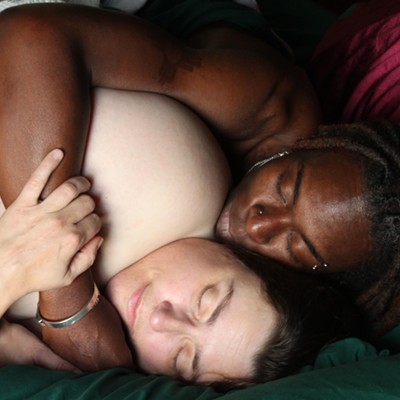Perhaps it's no surprise that in Pittsburgh -- where there always seems to be one last snow in store -- we have a hard time distinguishing between tropical plants. But that's not a pineapple; it's a lotus blossom. More or less.
The lotus is a treasured symbol in Buddhism, a religion whose practice is widespread throughout Vietnam and Southeast Asia. One of the principal texts in Buddhism, in fact, is the "Lotus Sutra," and numerous Buddhist sages have used the flower to suggest symbolic meanings and tenets of the faith. Think of the lotus as the shamrock of Southeast Asia -- a common plant that sums up the faith's key mysteries. For example, the lotus grows in pools of stagnant water, suggesting that great truths can spring from humble beginnings; each of its petals is used to suggest one precept of the "Eightfold Path" to enlightenment, and so on.
Most importantly, the lotus has been used as a symbol of peace, which is the function it serves in the Vietnam Memorial. Designed by a Mount Lebanon landscape designer, John Middleton, and built in 1987, the memorial is supposed to suggest lotus petals. But for those who still have trouble seeing a lotus in the sculpture, the legend "Grant Us Peace" is etched at the statue's base. (And for those who have trouble reading English, the same legend is also inscribed in Vietnamese.)
Of course, the sculpture is kind of pineapple-shaped. That's because it was designed to enclose a couple of smaller statues housed within it. These smaller statues re-enact two homecoming scenes: One features a soldier coming home to his wife, the other returning to his child. The sculpture also includes the names of the dead, and a poem by local veteran Thomas McGarvey, who served in Vietnam between 1967 and 1968. The poem reads, in part, "Those who gave all -- live in our hearts / Those who are left -- continue to give."
McGarvey himself gave more than the poem: He also spearheaded the creation of the memorial, much of which was built with volunteers from the building trades. I spoke to McGarvey a few years ago. He told me that after returning from the war, "I tried to put all that behind me." But an almost chance encounter working on a labor dispute with the Veterans Administration got him interested in the project.
"I'll never forget the day we started unwrapping the designs," McGarvey recalled. Entries had been submitted from 40 states, but Middleton's stood out. "Some were beautiful, but as soon as we opened that one, we knew," McGarvey said.
The very thing that makes the design stand out -- its ample pineapple shape -- is part of what attracted McGarvey to it in the first place. "There is space for a lot of memories," he said, "a lot of things to happen here."
The most important of those things is healing. McGarvey and other planners wanted something less stark, and more sheltering, than the famed "Wall" memorial in Washington, D.C. Just as importantly, "[W]e didn't want to have someone standing there with a machine gun in his hand," McGarvey says. Instead, he was looking for something that could suggest the possibility for renewal and rebirth -- ideas suggested by the lotus blossom and Buddhism as a whole. The Wall is a sort of gash in the earth; Pittsburgh's Vietnam Memorial is a water flower floating near the river.
Or it's a big pineapple. Either way, there are much worse legacies for a war to leave behind.










